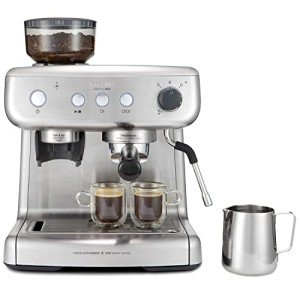The Reason Why You're Not Succeeding At Home Use Espresso Machines
Home Use Espresso Machines: A Comprehensive Guide
Espresso machines have ended up being a staple in numerous households as coffee lovers look for to duplicate café-quality brews in the convenience of their kitchens. The rise in popularity has caused a diverse market filled with various designs, functions, and rates. This article intends to provide a helpful overview of home use espresso machines, helping readers navigate their options efficiently.
Understanding Espresso Machines
Espresso machines work by forcing warm water through finely-ground coffee under high pressure, leading to a concentrated coffee beverage called espresso. There are numerous types of espresso machines categorized based upon their brewing methods and level of automation. The most common types include:
Manual Espresso Machines: These require the user to manage the pressure and water flow, enabling a more hands-on coffee-making experience.
Semi-Automatic Espresso Machines: These offer automatic control over water pressure, while the user manually grinds and tamps the coffee.
Automatic Espresso Machines: With the push of a button, these machines immediately manage the flow of water, making it simpler to brew espresso with constant outcomes.
Super-Automatic Espresso Machines: These all-in-one machines manage grinding, tampering, brewing, and even milk frothing, making them ideal for users looking for convenience.
Pill or Pod Machines: These use pre-packaged coffee pods to create espresso with minimal effort, however they limit option in brewing methods and tastes.
Table: Comparison of Espresso Machine Types
Type
Control Level
Alleviate of Use
Cleaning up Level
Suitable For
Manual
User-controlled
Moderate
High
Coffee perfectionists
Semi-Automatic
Partial automation
Moderate
Moderate
Home baristas
Automatic
Totally automated
Easy
Low
Busy individuals
Super-Automatic
Fully automated
Really easy
Really low
Convenience seekers
Capsule/Pod
Totally automated
Very easy
Extremely low
Casual drinkers
Secret Features to Consider
When choosing a home use espresso machine, it's necessary to consider various functions that can considerably affect the quality of espresso and user experience.
Pressure: Look for machines that provide at least 9 bars of pressure, as this is thought about ideal for developing espresso.
Boiler Systems: Single vs. dual boiler systems figure out temperature level stability and the capability to brew espresso and steam milk all at once.
Grinder: Integrated grinders enable newly ground coffee, which improves taste. Consider machines with adjustable grind settings.
Milk Frother: For those who enjoy cappuccinos and lattes, an integrated steam wand or automatic frother is vital.
Size and Design: Consider your cooking area space and visual choices. Machines are available in different sizes, from compact to big setups.
Cost: Home espresso machines can range from a few hundred to numerous thousand dollars, so it's crucial to establish a budget before checking out options.
Benefits and drawbacks of Home Use Espresso Machines
Pros
Cons
Benefit of brewing coffee in the house
Initial investment can be high
Quality of espresso is often superior
Needs some skill, specifically with manual machines
Capability to try out tastes
Upkeep and cleansing can be labor-intensive
Can conserve money in the long run
Not all machines will fit every coffee choice
Maintenance and Cleaning Tips
Keeping an espresso machine is vital for extending its life and making sure consistent brew quality. Here are some helpful ideas:
Regular Descaling: Minerals from water can develop up in the machine. Descale every 1-3 months, depending upon water hardness.
Daily Cleaning: Rinse portafilters, baskets, and steam wands after each use to avoid coffee oils from developing residue.
Use Filtered Water: This can help in reducing mineral buildup and enhance the taste of coffee.
Change Gaskets and Seals: These elements might wear gradually and needs to be changed to keep pressure and performance.
Check out the Manual: Each machine has particular care guidelines; following these will ensure durability.
FAQs About Home Use Espresso Machines
**Q1: What is the very best budget espresso machine?The best budget espresso machine typically depends upon specific requirements, however designs like the DeLonghi EC155 or the Breville Bambino are popular amongst users for supplying fantastic worth. Q2: How long do home espresso machines usually last?With proper maintenance, home espresso machines can last anywhere from 5 to 15 years, depending upon the quality of the machine and frequency of use. Q3: Can I make coffees and lattes with any espresso machine?While most espresso machines can make cappuccinos and lattes, having a reliable
steam wand or frother is necessary for accomplishing the ideal milk texture.
Q4: Are super-automatic machines worth the investment?For those who prioritize benefit and quick developing, super-automatic machines can be worth the financial investment, though they might lack some customizability in brew strength and flavor. Q5: What kinds of coffee beans are best for espresso?While personal choice contributes, beans labeled as” espresso “blends are normally roasted darker, producing abundant flavors and a creamy texture when brewed.
Investing in a home espresso machine can transform the day-to-day coffee routine into something special, raising home brews to café quality. By comprehending the different types of machines, key features to think about, upkeep needs, and weighing the
pros and cons, consumers can make educated decisions that fit their private choices. As the espresso culture continues to grow, no matter the option, every brew can be a delicious experience waiting to be appreciated.  **
**